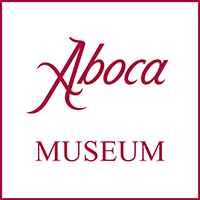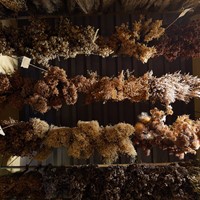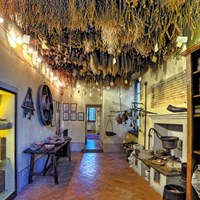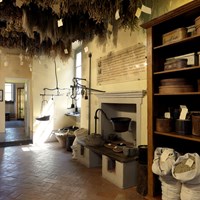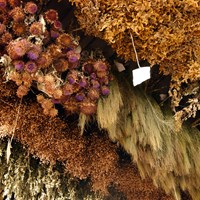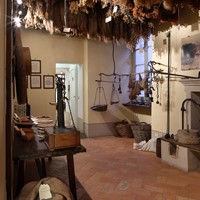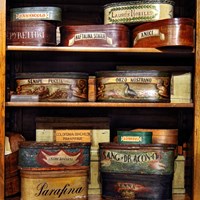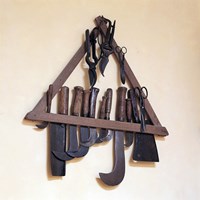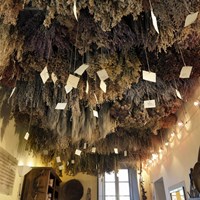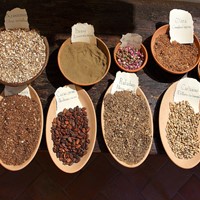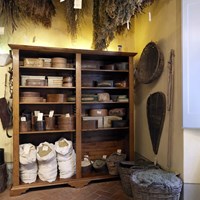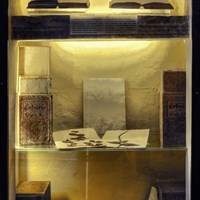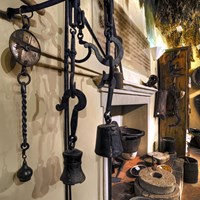The Herb Room
An array of medicinal plants hung in bunches to dry make the ceiling a colourful and fragrant thatch of herbs
The visitor then enters the most fascinating part of the whole museum, the herb room. Thick bunches of medicinal plants hang to dry, making the ceiling a colourful and fragrant thatch.
The herb gathering process was preceded by a daily observation of the plant’s growth, to select those with the greatest medicinal properties.
Most importantly, the right balsamic time had to be observed, that is, the period of the year in which the useful part of the plant reaches its highest content of active substances.
Hung in dry, airy rooms and away from direct sunlight, the herbs were dried and underwent changes that prepared them to be reduced into medicinal products. The herbs were then stored in special containers such as wicker baskets and precious wooden boxes, finely decorated with cartouches bearing the name of the plant.
Finally, the ancient tools for collecting and processing the herbs cannot be forgotten, as well as “propitiatory verbal tools”, such as prayers, invocations, rituals and popular beliefs that existed for every type of plant.
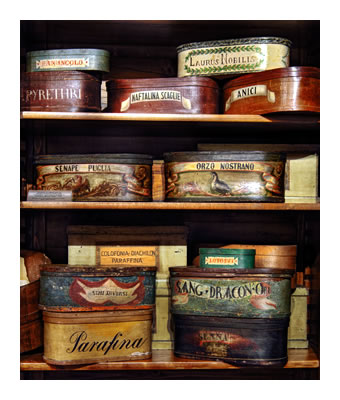
The herbs gathering process is preceded by a daily observation of the seedlings’ growth stage. The aim is that of identifying and culling the most perfect specimens, those being the ones with the best medicinal properties.
The “balsamic time”, that is, the right growth stage, is generally reached at blossom time. Nevertheless, a further ripening stage may be needed in order to gather fruits or seeds. The right time for gathering is to be determined with great accuracy, according to the lunar cycle and, especially, to meteorological conditions. Heavy showers or a prolonged dry spell may in fact irreparably damage the plants’ precious properties.
The actual gathering process also requires careful observation and skilfulness since the parts to be plucked vary from one species to the other. In any case, the integrity of the plant, or of its useful parts, needs safeguarding so as not to compromise the precious harvest.
The last fundamental phase is preservation. Age-old effective techniques are used to this end: among these drying takes the lead. The drying process removes water from the plant without dispersing its physical and chemical properties. Herbs are hanged in a dry, airing place, sheltered from direct light; here they slowly undergo those changes that will turn them into healing medical components.
Man and medicinal plants
Knowing to collect, to transform and to employ herbs in order to cure was a patrimony of acquaintances that, transmitted for oral way, gave wealth and power to the healer. One of the secrets more jealously guarded regarded the places, the times, the techniques of collection - often rituals- of the most active herbs against specific diseases.This was a virtue that, even though practiced in marginal field, since VIth century was fought from powerful organs, when the ritual aspect assumed exasperates connotes. Infact, during Inquisition, some healers ended for being considered "witches". The role of medicinal herbs, however, has been maintained alive in every local tradition, and has been fundamental for health until today, in spite of "scientific use" it has minimized the peculiar characteristics of naturalness.
PRAYERS FOR HERBS COLLECTION.
Camomile collection
Camomile, great drug for sick eyes, has to be always collected before the sun rise, pronouncing before this invocation: "I collect You, grass, for pupilla's white circle and for pain to the eyes, so that you can aid me". After you need to hung it to the neck.
Cyclamen collection
To recover spleen pain is important collect the whole cyclamen's tuber on the last Thursday of lunar cycle. Then we go on the room's threshold where the sick one is and there we cut the tuber in three slices asking him: "what do I cut?" And he should answer: "my spleen". After that we lean the cyclamen's slices on the sick part and say: "How will be dried the pieces of this cyclamen, so will be dried the spleen of this sick man".
Ebbio collection
Before collecting ebbio, must recite ter novies - 27 times - the propitiatory invocation: "Omnia mala beast song". (I beast declaim all the evils). Then it must be cut three times close to earth with a sharpenned iron, thinking intensely, in the meantime, to the disease that is wanted to be recovered. Once cutted, it does not have to be watched, but it must be crumbled and chewed giving the back.
Mandrake collection
In order to pick mandrake dig around the plant, then take one rope, tie an extremity to the plant's root and the other to a dog. Then call the dog so when this is coming towards to you he tears away the root. It is important to make this in a full moon night and remember to turn your ears deaf, in order not to feel the strong scream that the plant will shout in the moment of the tear.
